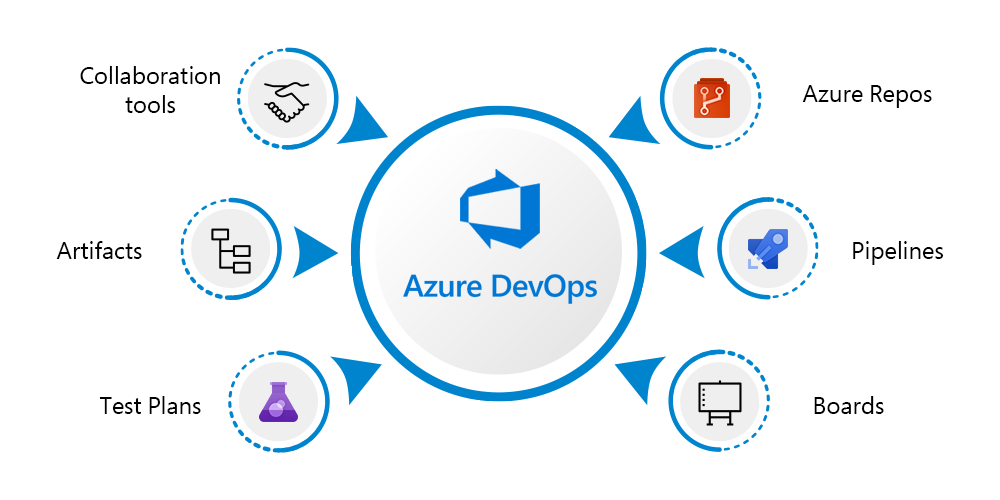Navigating the Cloud: Power of Azure DevOps
 Sumit Mondal
Sumit Mondal
Introduction:
In the ever-evolving landscape of technology, the marriage of cloud computing and development operations has given rise to a revolutionary concept: Azure DevOps. This dynamic platform seamlessly integrates tools, processes, and technologies, providing a collaborative environment for software development and deployment. In this blog, we embark on a journey to explore the multifaceted world of Azure DevOps, unraveling its layers and showcasing its prowess through a hands-on example.
Understanding Azure DevOps:
Azure DevOps is not merely a set of tools; it's a holistic approach to the software development life cycle. It encompasses five key pillars: Plan, Develop, Build, Test, and Release. Each pillar serves a distinct purpose, contributing to the efficiency and effectiveness of the development process.
Plan: The planning phase sets the foundation for a successful project. Azure Boards, a component of Azure DevOps, facilitates collaborative work item tracking and project management. It allows teams to plan, track, and discuss work across the entire development process.
Develop: Azure Repos provides version control services, enabling teams to manage and track code changes efficiently. It supports both centralized and distributed version control, empowering developers to collaborate seamlessly.
Build: Continuous Integration (CI) is a cornerstone of modern software development. Azure Pipelines automates the build process, ensuring that code changes are integrated and tested regularly. This minimizes integration issues and allows for early detection of potential bugs.
Test: Azure DevOps supports a variety of testing methodologies, from unit testing to performance testing. With Azure Test Plans, teams can manage and track testing efforts, ensuring the delivery of high-quality software.
Release: Azure Releases automates the deployment process, making it repeatable and reliable. This ensures that software is delivered to production or staging environments consistently, reducing the likelihood of deployment errors.
Hands-On Example: Deploying a Web Application
Let's dive into a practical example to illustrate the power of Azure DevOps. We'll walk through the process of deploying a simple web application using Azure DevOps.
Setting up the Project: Create a new project in Azure DevOps and initialize a Git repository using Azure Repos. This is where our source code will reside.
Building the Pipeline: Use Azure Pipelines to create a CI/CD pipeline. Configure a build pipeline to compile the code, run tests, and generate artifacts. This ensures that only successfully built and tested code progresses to the next stage.
Defining the Release Pipeline: Create a release pipeline to deploy the web application. Azure DevOps supports a variety of deployment targets, including Azure App Service, Kubernetes, and more. Define the deployment stages and configure any necessary environment variables.
Integration with Azure Resources: Leverage Azure Resource Manager (ARM) templates to define the infrastructure required for the application. This can include Azure App Service plans, databases, and other resources.
Monitoring and Feedback: Implement Application Insights, a powerful monitoring and analytics tool by Azure, to gain insights into the application's performance. This ensures that any issues are detected and addressed promptly.
Conclusion:
Azure DevOps is a game-changer in the world of software development, providing a comprehensive suite of tools and services that streamline the development life cycle. From planning to deployment, Azure DevOps fosters collaboration, automation, and continuous improvement.
As we witnessed through our hands-on example, deploying a web application becomes a structured and efficient process with Azure DevOps. The platform's flexibility and extensibility make it suitable for projects of all sizes and complexities. As technology continues to advance, embracing tools like Azure DevOps becomes not just a choice but a necessity for those aiming to stay ahead in the competitive realm of software development.
Subscribe to my newsletter
Read articles from Sumit Mondal directly inside your inbox. Subscribe to the newsletter, and don't miss out.
Written by

Sumit Mondal
Sumit Mondal
Hello Hashnode Community! I'm Sumit Mondal, your friendly neighborhood DevOps Engineer on a mission to elevate the world of software development and operations! Join me on Hashnode, and let's code, deploy, and innovate our way to success! Together, we'll shape the future of DevOps one commit at a time. #DevOps #Automation #ContinuousDelivery #HashnodeHero